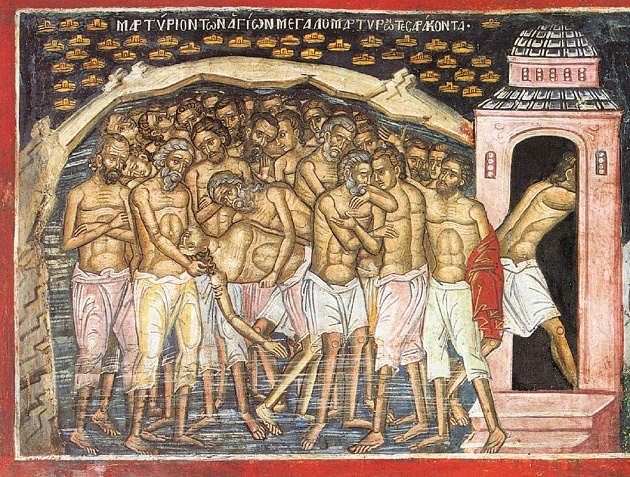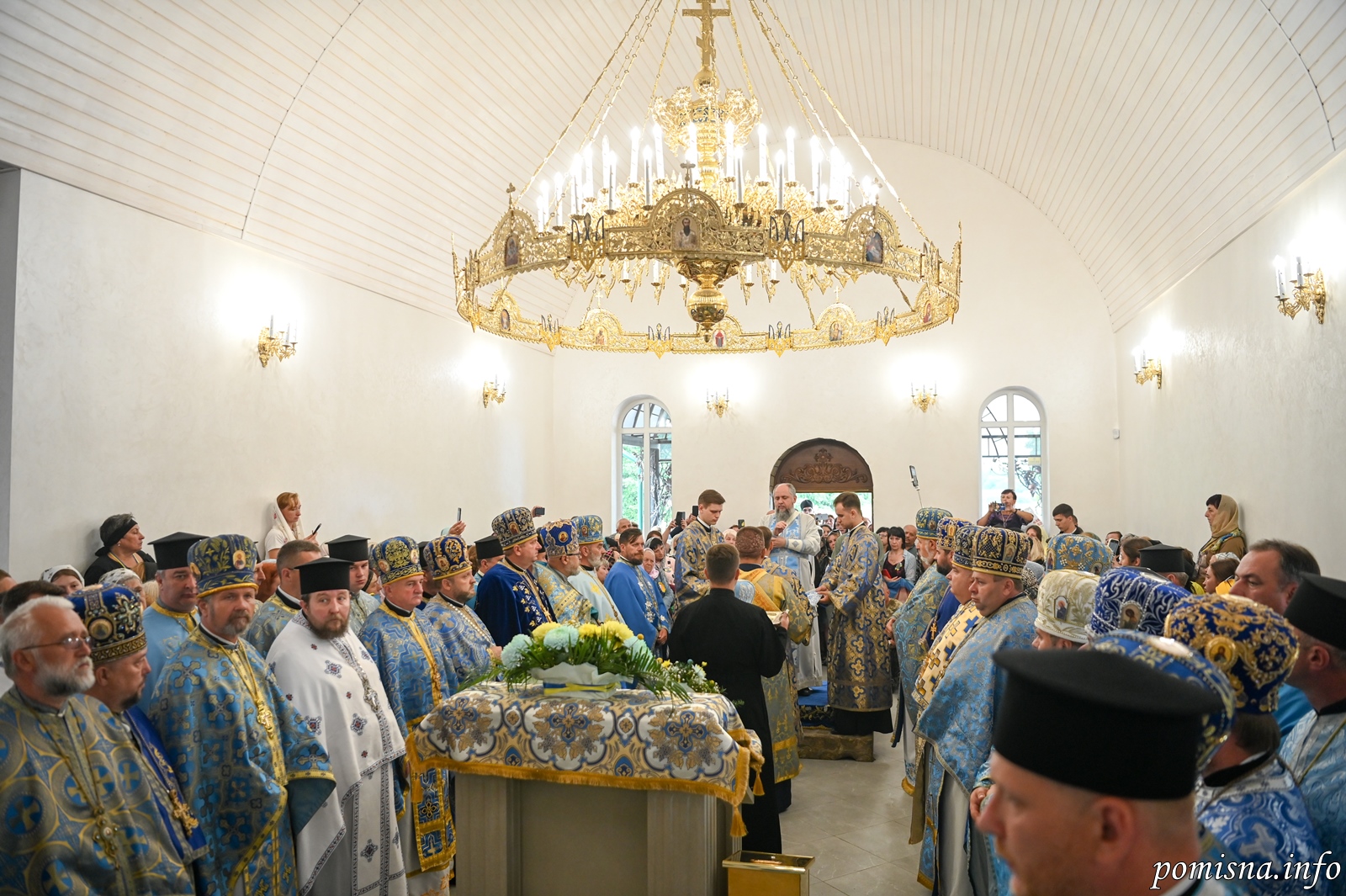40 Holy Martyrs of Sebaste (9 March)


For 2024, the Feast Day of the 40 Holy Martyrs of Sebaste is moved to 8 March due to the commemoration of Soul Saturday on 9 March 2024.
In the year 313 Saint Constantine the Great issued an edict granting Christians religious freedom, and officially recognizing Christianity as equal with paganism under the law. But his co-ruler Licinius was a pagan, and he decided to stamp out Christianity in his part of the Empire. As Licinius prepared his army to fight Constantine, he decided to remove Christians from his army, fearing mutiny.
One of the military commanders of that time in the Armenian city of Sebaste was Agricola, a zealous champion of idolatry. Under his command was a company of forty Cappadocians, brave soldiers who had distinguished themselves in many battles. When these Christian soldiers refused to offer sacrifice to the pagan gods, Agricola locked them up in prison. The soldiers occupied themselves with prayer and psalmody, and during the night they heard a voice saying, “Persevere until the end, then you shall be saved.”
On the following morning, the soldiers were again taken to Agricola. This time the pagan tried flattery. He began to praise their valor, their youth and strength, and once more he urged them to renounce Christ and thereby win themselves the respect and favor of their emperor.
Seven days later, the renowned judge Licius arrived at Sebaste and put the soldiers on trial. The saints steadfastly answered, “Take not only our military insignia, but also our lives, since nothing is more precious to us than Christ God.” Licius then ordered his servants to stone the holy martyrs. But the stones missed the saints and returned to strike those who had thrown them. One stone thrown by Licius hit Agricola in the face, smashing his teeth. The torturers realized that the saints were guarded by some invisible power. In prison, the soldiers spent the night in prayer and again they heard the voice of the Lord comforting them: “He who believes in me, though he die, yet shall he live (John 11:25). Be brave and fear not, for you shall obtain imperishable crowns.”
On the following day the judge repeated the interrogation in front of the torturer, but the soldiers remained unyielding.
It was winter, and there was a severe frost. They lined up the holy soldiers, threw them into a lake near the city, and set a guard to prevent them from coming out of the water. In order to break the will of the martyrs, a warm bath-house was set up on the shore. During the first hour of the night, when the cold had become unbearable, one of the soldiers made a dash for the bath-house, but no sooner had he stepped over the threshold, then he fell down dead.
During the third hour of the night, the Lord sent consolation to the martyrs. Suddenly there was light, the ice melted away, and the water in the lake became warm. All the guards were asleep, except for Aglaius, who was keeping watch. Looking at the lake he saw that a radiant crown had appeared over the head of each martyr. Aglaius counted thirty-nine crowns and realized that the soldier who fled had lost his crown.
Aggias then woke up the other guards, took off his uniform and said to them, “I too am a Christian,” and he joined the martyrs. Standing in the water he prayed, “Lord God, I believe in You, in Whom these soldiers believe. Add me to their number, and make me worthy to suffer with Your servants.” Then a fortieth crown appeared over his head.


In the morning, the torturers saw with surprise that the martyrs were still alive, and their guard Aggias was glorifying Christ together with them. They led the soldiers out of the water and broke their legs. During this horrible execution the mother of the youngest of the soldiers, Meliton, pleaded with her son to persevere until death.
They put the bodies of the martyrs on a cart and committed them to fire. Young Meliton was still breathing, and they left him on the ground. His mother then picked up her son, and on her own shoulders she carried him behind the cart. When Meliton drew his last breath, his mother put him on the cart with the bodies of his fellow sufferers. The bodies of the saints were tossed in the fire, and their charred bones were thrown into the water, so that Christians would not gather them up.
Three days later the martyrs appeared in a dream to Saint Peter, Bishop of Sebaste, and commanded him to bury their remains. The bishop together with several clergy gathered up the relics of the glorious martyrs by night and buried them with honor.
There is a pious custom of baking “skylarks” (pastries shaped like skylarks) on this day, because people believed that birds sing at this time to announce the arrival of spring. Forty “skylarks” are prepared in honor of the Forty Martyrs.
The names of the forty martyrs are: Cyrion (or Quirio), Candidus, Domnus, Hesychius, Heraclius, Smaragdus, Eunocius (Or Eunicus), Valens, Vivianus, Claudius, Priscus, Theodulus, Eutychius, John, Xanthius, Helianus, Sisinius, Aggias, Aetius, Flavius, Acacius, Ecdicius, Lysimachus, Alexander, Elias, Gorgonius, Theophilus, Dometian, Gaius, Leontuis, Athanasius, Cyril, Sacerdon, Nicholas, Valerius, Philoctimon, Severian, Chudion, Aglaius, and Meliton.
These holy Martyrs, who came from various lands, were all soldiers under the same general. Taken into custody for their faith in Christ, and at first interrogated by cruel means, they were then stripped of their clothing and cast onto the frozen lake which is at Sebastia of Pontus, at a time when the harsh and freezing weather was at its worst. They endured the whole night naked in such circumstances, encouraging one another to be patient until the end. He that guarded them, named Aglaius, who was commanded to receive any of them that might deny Christ, had a vision in which he saw heavenly powers distributing crowns to all of the Martyrs, except one, who soon after abandoned the contest. Seeing this, Aglaius professed himself a Christian and joined the Martyrs on the lake, and the number of forty remained complete. In the morning, when they were almost dead from the cold, they were cast into fire, after which their remains were thrown into the river. Thus they finished the good course of martyrdom in 320, during the reign of Licinius. These are their names: Acacius, Aetius, Aglaius, Alexander, Angus, Athanasius, Candidus, Chudion, Claudius, Cyril, Cyrion, Dometian, Domnus, Ecdicius, Elias, Eunoicus, Eutyches, Eutychius, Flavius, Gaius, Gorgonius, Helianus, Heraclius, Hesychius, John, Lysimachus, Meliton, Nicholas, Philoctemon, Priscus, Sacerdon, Severian, Sisinius, Smaragdus, Theodulus, Theophilus, Valens, Valerius, Vivianus, and Xanthias.
All of them were soldiers in the Roman army and steadfastly believed in the Lord Jesus. When the persecution of Christians began during the reign of Licinius, they were brought to trial before the commander. When he threatened to strip them of their honor as soldiers, one of them, St. Candidus, responded: “Take away from us not only the honor of being soldiers but also our bodies, for nothing is more dear or honorable to us than Christ our God.” After that, the commander ordered his servants to stone the holy martyrs. While the servants were hurling stones at the Christians, the stones turned and fell back on the servants, forcefully striking them. One of the stones struck the commander’s face and knocked out his teeth. The torturers, angry as wild beasts, bound all of the holy martyrs and threw them into the lake. They then stationed a guard around the lake to prevent any of them from escaping.
There was a terrible frost, and the lake froze around the bodies of the martyrs. To increase their pain and suffering, and to persuade even one of them to deny Christ and acknowledge the idols of Rome, the torturers heated and illumined a bath by the side of the lake in sight of the frozen martyrs. Indeed, one of them was persuaded. He came out of the water and entered the bath. And behold, from heaven there appeared an extraordinary light, which warmed the water in the lake and the bodies of the martyrs. With that light, thirty-nine wreaths descended from heaven over their heads. Upon seeing this, a guard on the shore removed all his clothes, confessed the name of the Lord Jesus and entered the lake so that he could become worthy of the fortieth wreath in place of the betrayer. Indeed, the last wreath descended upon him. The next day the entire town was astonished when they saw that the martyrs were still alive.
Then the wicked judges ordered that the lower part of their legs be broken and their bodies thrown into the water so that the Christians could not recover them. On the third day the martyrs appeared to Peter, the local bishop, and summoned him to gather their relics and remove them from the water The bishop with his clergy went out in the dark of night and beheld the relics of the martyrs shining brightly in the water. Every bone which was separated from their bodies floated to the top and glowed like a candle. Bishop Peter gathered and honorably buried them. The souls of these martyrs went to the Lord Jesus, Who suffered for all of us and resurrected with glory. They suffered honorably and were crowned with unfading glory in the year 320 A.D.
Apolytikion of 40 Martyrs of Sebastia
First Tone
Be entreated, O Lord, by the sufferings endured for You by the Saints, and we pray You, heal all our pain.
Kontakion of 40 Martyrs of Sebastia
Plagal of the Second Tone
O Forty Champions of the Lord, you abandoned the armies of the world and attached yourselves to the Master in heaven. Having gone through fire and water, O Blessed Ones, you worthily won glory from heaven and a multitude of crowns.
Source: oca.org / goarch.org / westserbdio.org




